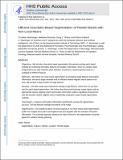Efficient Descriptor-Based Segmentation of Parotid Glands With Nonlocal Means
Author(s)
Wachinger, Christian; Brennan, Matthew (Matthew Stewart); Sharp, Greg C.; Golland, Polina
DownloadAccepted version (1.528Mb)
Terms of use
Metadata
Show full item recordAbstract
OBJECTIVE: We introduce descriptor-based segmentation that extends existing patch-based methods by combining intensities, features, and location information. Since it is unclear which image features are best suited for patch selection, we perform a broad empirical study on a multitude of different features.METHODS: We extend nonlocal means segmentation by including image features and location information. We search larger windows with an efficient nearest neighbor search based on kd-trees. We compare a large number of image features.RESULTS: The best results were obtained for entropy image features, which have not yet been used for patch-based segmentation. We further show that searching larger image regions with an approximate nearest neighbor search and location information yields a significant improvement over the bounded nearest neighbor search traditionally employed in patch-based segmentation methods.CONCLUSION: Features and location information significantly increase the segmentation accuracy. The best features highlight boundaries in the image.SIGNIFICANCE: Our detailed analysis of several aspects of nonlocal means-based segmentation yields new insights about patch and neighborhood sizes together with the inclusion of location information. The presented approach advances the state-of-the-art in the segmentation of parotid glands for radiation therapy planning.
Date issued
2017-07Department
Massachusetts Institute of Technology. Computer Science and Artificial Intelligence LaboratoryJournal
IEEE Transactions on Biomedical Engineering
Publisher
Institute of Electrical and Electronics Engineers (IEEE)
Citation
Wachinger, Christian et al. "Efficient Descriptor-Based Segmentation of Parotid Glands With Nonlocal Means." IEEE Transactions on Biomedical Engineering 64, 7 (July 2017): 1492 - 1502 © 2017 IEEE
Version: Author's final manuscript
ISSN
0018-9294
1558-2531